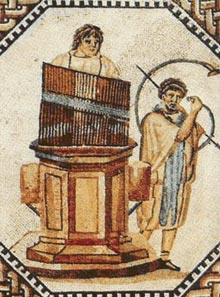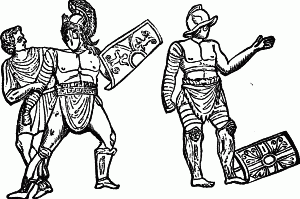Related Research Articles

A gladiator was an armed combatant who entertained audiences in the Roman Republic and Roman Empire in violent confrontations with other gladiators, wild animals, and condemned criminals. Some gladiators were volunteers who risked their lives and their legal and social standing by appearing in the arena. Most were despised as slaves, schooled under harsh conditions, socially marginalized, and segregated even in death.

The Colosseum is an elliptical amphitheatre in the centre of the city of Rome, Italy, just east of the Roman Forum. It is the largest ancient amphitheatre ever built, and is still the largest standing amphitheatre in the world, despite its age. Construction began under the emperor Vespasian in 72 and was completed in 80 AD under his successor and heir, Titus. Further modifications were made during the reign of Domitian. The three emperors who were patrons of the work are known as the Flavian dynasty, and the amphitheatre was named the Flavian Amphitheatre by later classicists and archaeologists for its association with their family name (Flavius).
Libitina, also Libentina or Lubentina, is an ancient Roman goddess of funerals and burial. Her name was used as a metonymy for death, and undertakers were known as libitinarii. Libitina was associated with Venus, and the name appears in some authors as an epithet of Venus.

Lucius Junius Brutus was the semi-legendary founder of the Roman Republic, and traditionally one of its first consuls in 509 BC. He was reputedly responsible for the expulsion of his uncle the Roman king Tarquinius Superbus after the suicide of Lucretia, which led to the overthrow of the Roman monarchy. He was involved in the abdication of fellow consul Tarquinius Collatinus, and executed two of his sons for plotting the restoration of the Tarquins.

Chariot racing was one of the most popular ancient Greek, Roman, and Byzantine sports. In Greece, chariot racing played an essential role in aristocratic funeral games from a very early time. With the institution of formal races and permanent racetracks, chariot racing was adopted by many Greek states and their religious festivals. Horses and chariots were very costly. Their ownership was a preserve of the wealthiest aristocrats, whose reputations and status benefitted from offering such extravagant, exciting displays. Their successes could be further broadcast and celebrated through commissioned odes and other poetry.

Venatio was a type of entertainment in Roman amphitheaters involving the hunting and killing of wild animals.

The gens Junia was one of the most celebrated families of ancient Rome. The gens may originally have been patrician, and was already prominent in the last days of the Roman monarchy. Lucius Junius Brutus was the nephew of Lucius Tarquinius Superbus, the seventh and last King of Rome, and on the expulsion of Tarquin in 509 BC, he became one of the first consuls of the Roman Republic.

A cornu or cornum was an ancient Roman brass instrument about 3 m (9.8 ft) long in the shape of a letter 'G'. The instrument was braced by a crossbar that stiffened the structure and provided a means of supporting its weight on the player's shoulder. Some specimens survive in the archaeological record, two from the ruins of Pompeii.

The inaugural games were held, on the orders of the Roman Emperor Titus, to celebrate the completion in AD 80 of the Colosseum, then known as the Flavian Amphitheatre. Vespasian began construction of the amphitheatre around AD 70 and it was completed by his son Titus, who became emperor following Vespasian's death in AD 79. Titus' reign began with months of disasters – including the eruption of Mount Vesuvius, a fire in Rome, and an outbreak of plague – he inaugurated the completion of the structure with lavish games that lasted for more than one hundred days, perhaps in an attempt to appease the Roman public and the gods.

A Samnite was a Roman gladiator who fought with equipment styled on that of a warrior from Samnium: a short sword (gladius), a rectangular shield (scutum), a greave (ocrea), and the helmet. Warriors armed in such a way were the earliest gladiators in the Roman games. They appeared in Rome shortly after the defeat of Samnium in the 4th century BC, apparently adopted from the victory celebrations of Rome's allies in Campania. By arming low-status gladiators in the manner of a defeated foe, Romans mocked the Samnites and appropriated martial elements of their culture.

Ludi were public games held for the benefit and entertainment of the Roman people . Ludi were held in conjunction with, or sometimes as the major feature of, Roman religious festivals, and were also presented as part of the cult of state.

Damnatio ad bestias was a form of Roman capital punishment where the condemned person was killed by wild animals, usually lions or other big cats. This form of execution, which first appeared during the Roman Republic around the 2nd century BC, had been part of a wider class of blood sports called Bestiarii.
The gens Modia was a minor family at Ancient Rome, known from a small number of individuals.

In ancient Rome, the pompa circensis was the procession that preceded the official games (ludi) held in the circus as part of religious festivals and other occasions.
The gens Helvidia was a plebeian family at Rome. Members of this gens are first mentioned in the final decades of the Republic. A century later, the Helvidii distinguished themselves by what has been called their "earnest, but fruitless, patriotism."
The gens Mettia, also written Metia, was a plebeian family at ancient Rome. Few members of this gens occur in history, and none attained the higher offices of the Roman state under the Republic. Several Mettii rose to prominence in imperial times, with at least three obtaining the consulship in the late first and early second century.
The gens Novia was a minor plebeian family at ancient Rome. Members of this gens first appear during the final century of the Republic, but the first of the Novii to obtain the consulship was Decimus Junius Novius Priscus in AD 78.
The phrase Shirt of Flame refers either to a specific form of the poison dress trope in folklore, or to a particular type of clothing given to people about to face burning at the stake.
The gens Scantinia was a minor plebeian family at ancient Rome. Members of this gens are first mentioned in the third century BC, but few of them held positions of importance in the Roman state.
References
- ↑ "Roman Times: The Tunica Molesta: Roman Execution Ad Flammas". 9 December 2010.
- 1 2 3 JUVENALIS, Decimus Junius, et al. The Satires of Juvenal and Persius. With English Notes from the Best Commentators, by C. Anthon ... New Edition, Revised by J. T. Wheeler. United Kingdom, n.p, 1858.
- ↑ Fiery Finery
- 1 2 Hubbard, Ben. Gladiators. United States, Cavendish Square Publishing LLC, 2016.
- ↑ Wiedemann 2002, pp. 86, 185.
- ↑ Wiedemann 2002, pp. 1–6.
- 1 2 Wiedemann 2002, p. 1.
- ↑ Shear, Julia L. Serving Athena: The Festival of the Panathenaia and the Construction of Athenian Identities. N.p., Cambridge University Press, 2021. ISBN 9781108618021
- 1 2 Wiedemann 2002, p. 2.
- ↑ Wiedemann 2002, p. 3.
- 1 2 Wiedemann 2002, p. 5.
- ↑ Kyle 2012, p. introduction, 7.
- ↑ Mahoney 2001, p. vii.
- ↑ Closs 2020, p. 256.
- ↑ Wiedemann 2002, pp. 85–87.
- 1 2 Wiedemann 2002, p. 85.
- 1 2 3 4 5 6 7 Kyle 2012, p. 170.
- ↑ Wiedemann 2002, p. 86.
- ↑ Tertullian, Apologeticus 50.3: "Licet nunc sarmenticiōs et sēmaxiōs appellētis, quia ad stīpitem dīmidiī axis revīnctī sarmentōrum ambitū exūrimur[...]"
- ↑ Wiedemann 2002, pp. 87–88.
- ↑ The epigram referred to is Martial's Epigram 10.25.